Structural and thermodynamic properties of molecular complexes of aluminum and gallium trihalides with bifunctional donor pyrazine: decisive role of Lewis acidity in 1D polymer formation†
Abstract
Solid state structures of group 13 metal

* Corresponding authors
a
Inorganic Chemistry Group, Department of Chemistry, St. Petersburg State University, University Pr. 26, Old Peterhof, St. Petersburg, Russia
E-mail:
alextim@AT11692.spb.edu
b
Department of Inorganic Chemistry, University of Regensburg, 93040 Regensburg, Germany
E-mail:
manfred.scheer@chemie.uni-regensburg.de
Solid state structures of group 13 metal

 Please wait while we load your content...
Something went wrong. Try again?
Please wait while we load your content...
Something went wrong. Try again?
T. N. Sevastianova, M. Bodensteiner, A. S. Lisovenko, E. I. Davydova, M. Scheer, T. V. Susliakova, I. S. Krasnova and A. Y. Timoshkin, Dalton Trans., 2013, 42, 11589 DOI: 10.1039/C3DT50954K
To request permission to reproduce material from this article, please go to the Copyright Clearance Center request page.
If you are an author contributing to an RSC publication, you do not need to request permission provided correct acknowledgement is given.
If you are the author of this article, you do not need to request permission to reproduce figures and diagrams provided correct acknowledgement is given. If you want to reproduce the whole article in a third-party publication (excluding your thesis/dissertation for which permission is not required) please go to the Copyright Clearance Center request page.
Read more about how to correctly acknowledge RSC content.
 Fetching data from CrossRef.
Fetching data from CrossRef.
This may take some time to load.
Loading related content
